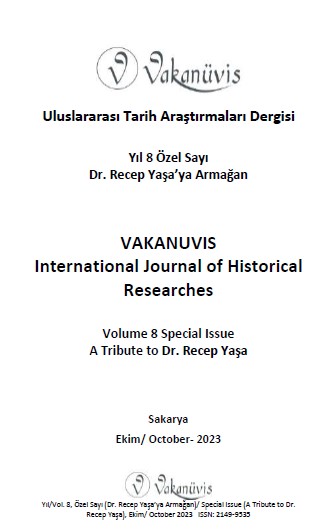Osmanlı Ordusu İçin At Yetiştirilmesi: Kütahya Hara-yı Hümâyûnu
Horse Breeding for the Ottoman Army: Kutahya Hara-yı Humayunu
Author(s): Emine Gedik, Arif KolaySubject(s): Military history, Military policy, 19th Century, The Ottoman Empire
Published by: Serkan YAZICI
Keywords: Kütahya Barracks; Kütahya Stud Farm; Çifteler Stud Farm; Military Farm; Hungarian Horse; Kadana/Katana;
Summary/Abstract: Kütahya Barracks is one of the few centers where horse breeding for military purposes was carried out in the Ottoman Empire. Because Kütahya Barracks has suitable conditions for the shelter, care and feeding of animals. Therefore, right after the end of the Crimean War (1853-1856), two cavalry units consisting of foreign breed horses procured through purchase were placed in the Kütahya Barracks. As a matter of fact, this event formed the starting point of horse breeding for the army in Kütahya. The fact that the lack of animals in the Ottoman-Russian War (1877-1878), or in other words, the lack of animals in the 93 War, was a major factor in the loss of the war, led to the search for new solutions in order to provide sufficient and qualified animals to the army. As a matter of fact, under the responsibility of the Serasker office, it was decided to form modern stud farms in order to raise animals and improve their breeds. In this context, the military farm in Kütahya was structured as a stud farm, taking as an example the Çifteler Farm (1888), which was first converted into a stud farm. In Kütahya Stud Farm, drawbar horses, which are used to transport heavy loads such as towing cannon carts, were raised. These horses belong to cold-blooded breeds of Hungarian and European origin; He has a large and heavy body, developed muscles, double rump, long legs and calm temperament. II. After the Second Constitutional Monarchy, Kütahya Stud Farm shared the same fate with other stud farms and survived great hardships and sometimes came to the point of stopping its activities. Kütahya Stud Farm; Despite everything, he preserved a significant part of the animals he raised under the military roof until the collapse of the Ottoman Empire, and then transferred them to the newly established Republic of Turkey. In this study, the beginning of military horse breeding in Kütahya, the transformation process of a military horse farm into Hara-yı Hümâyun and the activities of Hara-yı Hümâyun were tried to be revealed. In the research, Ottoman archival documents and works related to the literature were consulted and content analysis, one of the qualitative research methods, was used.
Journal: Vakanüvis- Uluslararası Tarih Araştırmaları Dergisi
- Issue Year: 8/2023
- Issue No: Sp. Issue
- Page Range: 2548-2582
- Page Count: 35
- Language: Turkish

